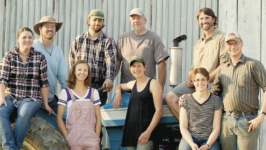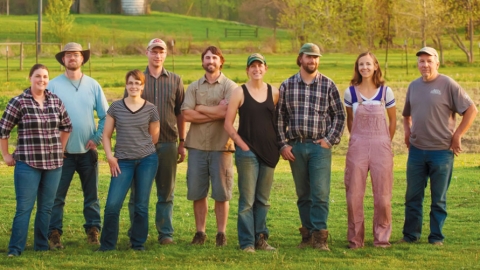An Apple a Day Keeps the Doctor Away
How the healthcare industry is teaming up with local farms to bring more food to the people
Eating for health is simple enough in theory, but much more complicated in practice. Many obstacles from farm to table can stand in the way of our daily fruit and vegetable consumption.
And yet, it’s the health sector that has emerged in recent years as an important driver in the growth of local food production. As the healthcare industry considers the cost-saving opportunities in prevention strategies, wellness initiatives that promote healthy eating are gaining momentum.
While smoking cessation and exercise programs are currently more popular, public health leaders are beginning to consider creative opportunities around food. With only a few nascent examples around the state, Ohio is just getting started.
“(Our) state is moving forward looking at healthy food access as a social determinant of health,” says Dr. Andrew Wapner of the Ohio Department of Health. “I think that’s a positive way to approach health care and population health.”
Andrew recently spearheaded the creation of Ohio’s Plan to Prevent and Reduce Chronic Disease. Released in 2014 after a collaborative process involving 150 health advocates, practitioners, and insurers, the five-year plan is a dynamic and priority-driven roadmap to better health. It was designed to preemptively address the lost productivity and rising healthcare costs caused by preventable conditions such as diabetes, heart disease, and obesity.
The plan calls for stakeholders to work together on the shared priorities that will impact policies and improve the systems and environments to spark better health outcomes. Improving access to healthy foods is one of several calls to action in the plan. Recommended tactics that will be encouraged and monitored over the next five years include increased access to farmers markets, more local fruits and vegetables in schools, and the creation of a statewide food policy council.
Living into these recommendations will require creativity and innovation. One model initiative to consider is the FairShare CSA (Community Supported Agriculture) Coalition in southern Wisconsin, an innovative partnership between health insurers and local farmers.
FairShare is the first health insurance rebate program for CSAs in the county. Founded in 2005 by one local health plan and a small group of farms, FairShare now includes four insurers with 50 farms providing 9,000 shares to more than 20,000 customers annually.
When CSAs began in the 1980s, they were considered a unique direct marketing strategy for small growers. They allow customers to make an up-front investment directly to the farmer, which in turn provides the cash required to plan for the season, purchase new seed, and make equipment repairs.
By bringing insurers into the mix, FairShare has sweetened the CSA pot. Policyholders are effectively rewarded for their healthy choices with a $200 reimbursement per family after they sign up and pay for a CSA share from a selection of 50 member farms, most of which are certified organic. This rebate effectively makes fresh, seasonal, locally, and organically grown fruits and vegetables more accessible to consumers by reducing the cost of a CSA share by up to 40%.
All involved say FairShare has been successful because of its triple-bottom-line approach—impacting public health outcomes, customers’ pocketbooks, and farmers’ bottom lines. With sales and outreach efforts handled by the coalition and insurers, growers have focused on expanding production and serving their larger consumer base. As Claire Strader of FairShare explains, “just the fact that the rebate is publicized by the insurers increases the profile of CSA in the community, which is good for farms, farmers, and local organic food.”
For those working to build a healthier and more sustainable food system, the unique success of FairShare’s collaboration cannot be understated. Despite the recent surge in farmers markets and popularity of buy-local campaigns, local food sales are still only estimated at 1.5% of the value of U.S. agricultural production.
Changing something as complex as our food system is a multifaceted and lengthy enterprise. It requires innovative approaches and cross-sector collaboration. Whatever the motivation—cultural, economic, environmental—all stakeholders in the food movement from farmers and health advocates to entrepreneurs to environmentalists must consider new approaches to the way we produce, consume, and distribute food.
There’s nothing stopping Ohio’s CSA growers, customers, insurers, and health advocates from replicating something like FairShare in our state. With the momentum of the Health Department’s Chronic Disease Prevention Plan at our backs, it will be exciting to see what healthy-eating innovations develop here.
1USDA Economic Research Service, Vogel, Stephen, and Sarah A. Law, “The Size and Scope of Locally Marketed Food Production,” February 2, 2015. (Indeed, federal support for “specialty crops”— the USDA’s name for the fruits and vegetables we eat—only makes up 1% of the $956 billion allocated in the 2014 Farm Bill.)






